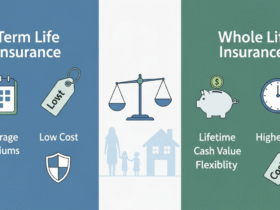Wellness-savvy traveler! It’s understandable if you are feeling the crunch from new health insurance costs and trying to find a way to alleviate those burdens. You certainly aren’t the only one. The world of health insurance can often feel like an intricate puzzle that is best avoided, but if you use the right tools, you can navigate through the complex web and uncover hidden solutions that will allow you to cut costs while still enjoying sufficient healthcare benefits.
In this publication, we will work towards identifying actionable methods that you can implement in order to reduce health insurance premiums. Consider this as your personal map that guides you towards intelligent and affordable coverage designed to cater to your specific requirements.
Key Takeaways
- Check Different Offers: Different service providers might have different pricing models, so make sure to check various offers.
- Increase Deductibles: When offered the choice, you might want to skip on insurance with lower premiums and opt in to insurance with higher deductibles instead.
- Maintain Physical Fitness: Regular physical activity contributes to health, making you eligible for lower costs.
- Preventive Care Savings: Spending less on preventive care services may lead to higher accumulative costs in the future.
- Evaluating Other Offers: The availability of alternative plans which include HSAs or other high deductible options is worth a thought.
Understanding Health Insurance Premiums: The Basics
Let’s take a step back and first define what health insurance premiums are and how they are determined before outlining the strategies to adopt.
What Are Health Insurance Premiums?
The health insurance premium is the monthly amount payable for insurance policies. This form of payment is treated independently from other expenses like deductibles, copayments, and coinsurance. You may consider it as the fee you pay to gain access to receive health care services.
Factors That Affect Premiums
A combination of factors such as the following will put you at a different level of payment:
- Age: Elderly persons are known to have a greater premium.
- Location: Insurance premium differs from state to state and even within areas of a state.
- Tobacco use: Insurance premium is more expensive to smokers.
- Plan category: Different plans e.g. Bronze Silver Gold differ in cost and level of coverage provided.
- Family size: Having more family members can increase premium.
With the understanding of these areas, you should be able to determine what quite works for you and where you are likely to save.
Strategies to Lower Your Health Insurance Premiums
Equipped with the fundamentals, let’s look at the practical steps you can take to reduce your health insurance premiums.
1. Shop Around and Compare Plans
Greater variety means a higher probability for meeting your individual needs thus checking for different plans ensures that you get maximum insurance for your minimum dollar.
- Use Online Marketplaces: Compare HealthCare.gov enables the side by side comparison of plans.
- Check for Subsidies: Depending on your financial situation, you could receive subsidies that reduce your premium.
- Review Plan Details: Look at other factors in addition to the premium and evaluate other charges like deductibles, co-pays, and out-of-pocket maximums.
2. Opt for a Higher Deductible
Your monthly premium will drop if you select a plan with a higher deductible.
- Evaluate Your Health Needs: If you are generally in good health and will not be requiring a lot of medical attention, then the high-deductible plan is likely the most economical option for you.
- Emergency Fund: Make sure you have funds set aside to meet the higher deductible if the medical cost surge is unexpected.
3. Maintain a Healthy Lifestyle
An active lifestyle can result in a lower premium, as many insurance providers reward such individuals.
- Exercise Regularly: Keeping physically active is good for your wellbeing and your insurance.
- Eat a Balanced Diet: Making sure that you take the right combination of foods has an important bearing on your health.
- Avoid Tobacco and Limit Alcohol: Both of these can result in higher premiums by increasing the likelihood of a number of diseases.
4. Utilize Preventive Care
Preventive care aims to reduce long-term expenses by addressing issues before they become significant, thereby reducing the treatment and possibly premium costs.
- Annual Check-ups: Regular consultations with your doctor help to detect health problems earlier.
- Vaccinations: Illness prevention through timely and adequate vaccinations.
- Screenings: Engage in preventative screenings for diseases such as cancer, diabetes, and heart disease.
5. Consider Alternative Plans
Looking into other options for health insurance may result in a reduced expenditure.
- Health Savings Accounts (HSAs): These accounts are available with high deductible plans. An HSA allows you to set aside funds for medical expenses on a tax-free basis.
- Catastrophic Plans: These plans have low premium rates but provide coverage for specific high-cost situations only.
- Short-Term Plans: These provide coverage at a lower price but are not comprehensive in nature.
Additional Tips to Reduce Health Insurance Costs
After examining the major strategies, such as plan comparisons, changing deductible amounts, and tiered coverages, there are some smaller, equally important ways to cut costs that might go unnoticed. These less obvious steps, however, could still make a substantial impact on your total expenditure. If reducing the expenses on insurance is of importance to you, here’s a practical approach that most people tend to forget until a later stage.
Perhaps the simplest and most impactful approach is to utilize insurance bundles. If you have auto, homeowners, or renters insurance, check to see whether your provider can consolidate them with your health insurance under one company. Many insurers offer partial loyalty discounts for bundled policies, and even if the savings appear minimal on a monthly basis, they accumulate over the year. Sometimes the reward goes beyond financial savings, as it can also simplify your billing and account management.
It’s prudent to revisit your strategy periodically, and especially once a year. Health insurance is not a “set it and forget it” service. There’s a stark reality in the fact that one’s life evolves along with the constantly shifting coverage landscape. New health concerns can arise, or on the contrary, someone may use fewer services than they did a year ago.
By reviewing your approach during open enrollment, you can optimize the chances of not overpaying for unneeded coverage or missing better coverage options that could save hundreds per year. For some reason, people tend to forget that taking 30 minutes once a year to compare plans can make a world of difference to so many people who fell prey to being stagnant with outdated plans.
A different approach towards saving money—particularly following treatment—is managing your bills directly. This may feel daunting, but a lot of health care providers are willing to negotiate. Perhaps the billed amount seems too high, or perhaps there are services listed that you do not remember. It is within your rights to receive an itemized bill, challenge anything opaque, and ask for a discounted rate.
Often times, doctors and hospitals have a set discount for upfront payment or can put you on a hardship plan that is easy to manage. Surprisingly, this step can save people real money in the thousands, particularly after surgeries, ER visits, or seeing a specialist.
And don’t forget the impact of using in-network providers. This suggestion may sound basic, but it ranks as one of the greatest causes of overspending. Each health insurance plan has a mapped out network of doctors, hospitals, and clinics that are willing to accept set rates.
Venturing outside the circle could mean paying full price, and your insurer may only provide a scant reimbursement, if any at all. Taking time to confirm that a scheduled provider is still within your plan’s network is prudent. Even with a referral from your regular doctor, it’s your responsibility to verify coverage. This is a small habit with the potential for great positive impact.
Sarah’s Journey to Affordable Health Coverage
Allow me to introduce to you someone I believe you will connect with; Sarah. She is thirty-five years old, resides in Austin, Texas and is a freelance graphic designer. Unlike most of us, self employed freelance workers enjoy the freedom and flexibility that comes with the position. However, Sarah found herself navigating a burdensome predicament, her health insurance premiums were steadily increasing alongside her expenses.
Every month, a large portion of her paycheck vanished to maintain coverage. And for what? She didn’t go to the doctor that often, and even then, there was a high deductible to meet, so it felt like there was no value in her health insurance. It didn’t feel right at all.
With some semblance of logic intact, she knew there was a better solution somewhere in the world. But in the middle of her career and other commitments, her digging for a better health insurance plan felt profoundly taxing.
After a seemingly endless discussion concerning the increasing expenses, something inside of her clicked- And that something along with a dose of self motivation able to take charge of her life was enough for Sarah.
For years, the one thing she didn’t want to do was browse online for health insurance. And to her surprise, by going to HealthCare.gov and checking the plans available, she uncovered a trove of opportunities for herself. It made clear to her the extent to which she had been paying above the market average.
One such revelation was a silver plan from another insurance with nearly same coverage but at a lower fee with superior tele health services and greater in-network coverage. The benefits of that tele health plan were enough to turn her life around.
Let us now explore Sarah’s Case Study. She changed plans to a higher deductible one, something she would never have dreamt of doing earlier. It felt a little risky initially but to counter that, she implemented an automated system that set aside money each month to build an emergency fund to address any unanticipated expenses.
Moreover, she was saving over 100 on premiums, which translates to over 1200 annually. It was more than just the money, it was about strategically choosing a plan that didn’t exceed her actual needs and aligning her healthcare requirements with the plan.
My Opinion
Cutting down health premiums is possible with proper planning, informed choices, and intentional lifestyle shifts. By exercising, opting for higher deductibles, using necessary preventive care, and maintaining a healthy lifestyle, insurance costs can be reduced without impacting a needed coverage. After all, the goal with insurance is to strike the right balance between cost and services offered.
For those interested, licensed agents are the best for comparing plans as they can guide you tailoring to your specific needs.





























Leave a Reply